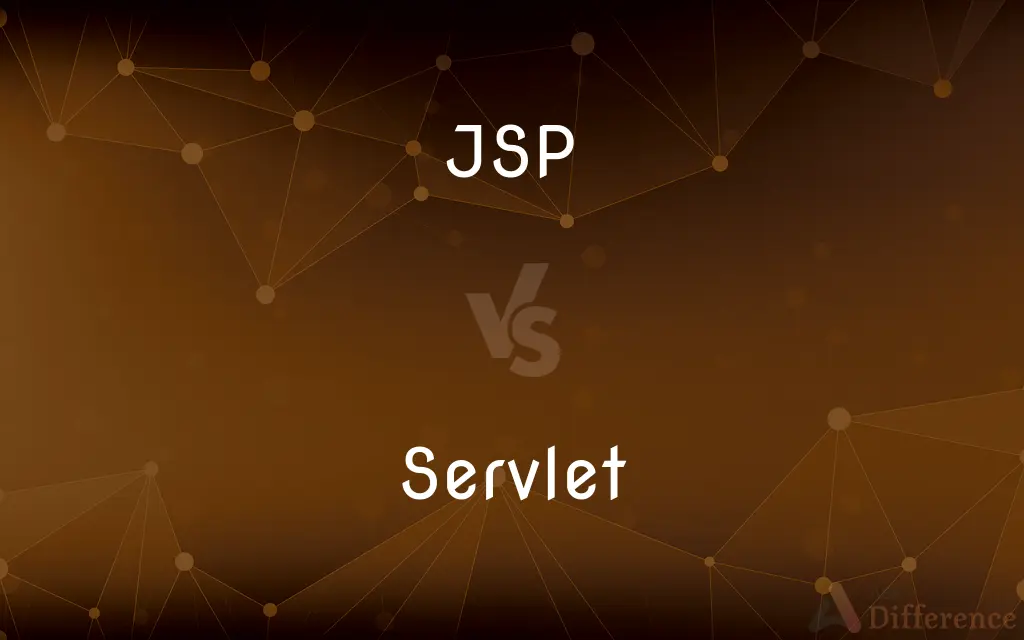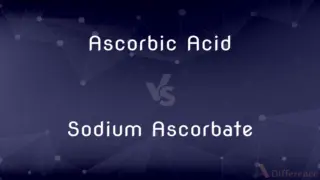JSP vs. Servlet — What's the Difference?
Edited by Tayyaba Rehman — By Fiza Rafique — Published on December 14, 2023
JSP (JavaServer Pages) allows embedding Java in web pages for dynamic content, while Servlets are Java classes that handle HTTP requests and responses.

Difference Between JSP and Servlet
Table of Contents
ADVERTISEMENT
Key Differences
JSP, or JavaServer Pages, is a technology that facilitates the embedding of Java code directly within web pages, making it easier for developers to create dynamic content. Servlets, on the other hand, are Java classes that act as intermediaries between a web client (like a browser) and a web server, handling HTTP requests and generating responses.
JSP was developed to address the complexity of writing user interfaces in Servlets. By allowing Java code to be embedded in HTML, JSP offers a more intuitive and streamlined way to build dynamic web pages. Conversely, Servlets focus on processing HTTP requests, managing sessions, and orchestrating application logic.
While both JSP and Servlets operate on the server side, their primary roles differ. JSP is predominantly used for presentation purposes, offering a way to seamlessly integrate Java functionalities into the web page's design. Servlets, in contrast, are workhorses that handle the underlying business logic, ensuring data processing, and communication with databases.
Another crucial distinction lies in their lifecycle and compilation. When a JSP file is accessed, it's converted into a Servlet and then compiled. This means that at their core, JSPs ultimately become Servlets. However, Servlets are directly written as Java classes and don't undergo this transformation.
Comparison Chart
Primary Purpose
Presentation, rendering dynamic web page content.
Handling HTTP requests and application logic.
ADVERTISEMENT
Development Style
Embedding Java code in HTML.
Writing Java classes to process web requests.
Lifecycle & Compilation
Converted into a Servlet when accessed, then compiled.
Directly written and compiled as Java classes.
Ease of Use for UI
Simplifies dynamic content creation in web pages.
More complex for user interface creation.
Underlying Operation
Ultimately transforms into a Servlet for execution.
Operates as a standalone Java class on the server.
Compare with Definitions
JSP
A technology for embedding Java code in web pages.
With JSP, developers can easily generate dynamic web content.
Servlet
A Java class handling HTTP requests and responses.
Servlets can manage user login and data retrieval processes.
JSP
A server-side script used to produce dynamic HTML.
JSP allows for real-time data display by fetching values from databases.
Servlet
A server-side technology to extend the capabilities of web servers.
Web applications use Servlets to interact with databases and return data to users.
JSP
An extension of Servlets focused on presentation.
JSP simplifies the task of creating user interfaces compared to Servlets.
Servlet
Part of the Java EE specifications.
Enterprise applications often rely on Servlets for back-end processing.
JSP
A part of the Java EE technology stack for web applications.
Many enterprise applications use JSP for their web page views.
Servlet
A precursor to JSP in generating dynamic web content.
Before JSP's introduction, Servlets were commonly used to create dynamic web pages.
Servlet
Directly interacts with the web container in the application server.
The Servlet gets initialized, then services requests, and finally is destroyed by the web container.
Servlet
A Java program running on an Internet server that generates web content dynamically in response to requests from clients.
Common Curiosities
How does JSP generate dynamic content?
JSP embeds Java code within HTML, which is executed server-side to produce dynamic content.
What is JSP used for?
JSP is used to create dynamic web content by embedding Java code within web pages.
Which is older, JSP or Servlet?
Servlet technology predates JSP.
How is data passed between JSP and Servlets?
Data can be passed using request and response objects, session management, or context attributes.
How is Servlet different from JSP?
Servlets are Java classes for handling HTTP requests, while JSP focuses on embedding Java in web pages for presentation.
Can JSP and Servlets coexist in a web application?
Yes, JSP often handles the presentation while Servlets manage the application logic.
How are Servlets typically invoked?
Servlets are invoked by web clients via HTTP requests.
Which has a more complex lifecycle, JSP or Servlet?
Both have their own lifecycles, but Servlets have a more explicit and often discussed lifecycle in Java development.
Why might developers choose JSP over Servlet for user interfaces?
JSP offers a more intuitive approach to blending Java functionality with web page design, making UI creation simpler.
Do I need a web container to run JSP and Servlets?
Yes, both JSP and Servlets require a web container, like Tomcat, for execution.
Do JSP and Servlets only work with Java-based applications?
They are Java technologies and integrate best with Java-based applications, but they can interact with other technologies through APIs and services.
Is JSP a replacement for Servlet?
No, JSP complements Servlet. While JSP is for presentation, Servlets handle the underlying business logic.
Can JSP handle HTTP requests directly?
JSP ultimately gets converted into Servlets, which then handle the HTTP requests.
Are Servlets multi-threaded?
Yes, for every new request, a new thread is spawned in the Servlet.
Can I use only Servlets to build a web application without JSP?
Yes, but it would make generating dynamic user interfaces more complex.
Share Your Discovery

Previous Comparison
Ascorbic Acid vs. Sodium Ascorbate
Next Comparison
IMPS vs. NEFTAuthor Spotlight
Written by
Fiza RafiqueFiza Rafique is a skilled content writer at AskDifference.com, where she meticulously refines and enhances written pieces. Drawing from her vast editorial expertise, Fiza ensures clarity, accuracy, and precision in every article. Passionate about language, she continually seeks to elevate the quality of content for readers worldwide.
Edited by
Tayyaba RehmanTayyaba Rehman is a distinguished writer, currently serving as a primary contributor to askdifference.com. As a researcher in semantics and etymology, Tayyaba's passion for the complexity of languages and their distinctions has found a perfect home on the platform. Tayyaba delves into the intricacies of language, distinguishing between commonly confused words and phrases, thereby providing clarity for readers worldwide.










































